94. Today in 1920s Turkey: Turkish Cartoonist Portraits and Profiles (Part III: The Curious Case of İsmail Hakkı Bey)
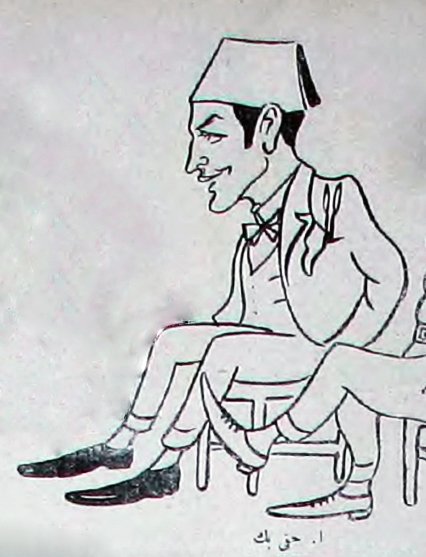
(Portrait of İsmail Hakkı, Akbaba or “Vulture/White-Bearded Old Man,” 7 June 1923, no. 53, page 5.)
Today we will be looking at the second artist in a seven-part series on Turkish cartoonists of the 1920s. The inspiration for this series came from a cartoon I uncovered featuring all of the artists on the roster of the prominent magazine, Akbaba.
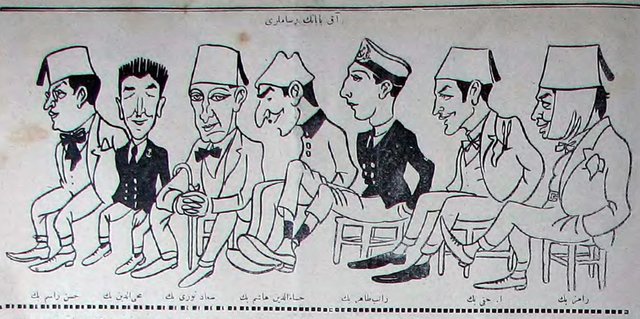
As such, we will be moving from right to left, one post at a time, exploring the lives, accomplishments, and oeuvres of these artists. Following last week’s post about Ramiz Bey, today’s post considers the second figure in Akbaba’s line-up of artists, İsmail Hakkı Bey (second from right).
My initial investigation into İsmail Hakkı Bey was not encouraging especially since I had never posted any cartoons by him (compare that with Ramiz, for instance, who now has 13 Today in 1920s Turkey posts dedicated to his work). Thus, having no prior experience with his art, I turned to my beloved and trusted source on Turkish cartoonists: Şefik Memiş and İbrahim Yarış’s book, Istanbul’s 100 Cartoonists (İstanbul’un 100 Karikatüristi). I will translate into English the first line in their entry for İsmail Hakkı: “There is not a lot of information on his life.” (“Hayatı hakkında fazla bilgi yoktur.”) The entry proceeds to say that, in addition to Akbaba he worked for the journals Zümrüdüanka and Aydede; he was especially active 1923-25. Lacking in this account was any educational background or a birth or death year, which the authors are usually very good about providing.
I briefly resigned myself to the failure—coming to terms with the notion that this may be the most boring, uninformative post ever. Then I decided to keep digging. A google search revealed no known cartoonists by the name of İsmail Hakkı. But how could an artist simply vanish into history? I then decided to flip through some issues of Akbaba from the 1923-5 period in hopes of finding some interesting cartoons by him... Completely by chance, this cartoon was on the front page of one of the first issues I clicked through:
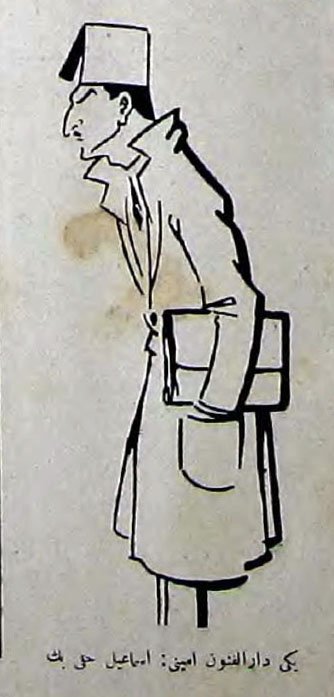
(“The new University’s President: İsmail Hakkı Bey,” Akbaba, 10 December 1923, no. 106, page 1.)
Could this be the same İsmail Hakkı? This gentleman does indeed have extensive biographical information available online. He was the first President of the newly organized “Darülfünun” or what will later be called “Istanbul University.” He later took on the last name “Baltacıoğlu” following Surname reform in 1934. I am not completely convinced they are the same person… but would I like them to be? Sure. “Baltacıoğlu” went on to write many important books, published the periodical Yeni Adam (New Man) and was involved in numerous pedagogical projects and educational reforms in Turkey in the 1930s and 40s. Baltacıoğlu was also an accomplished calligrapher, thus, he had a background in art. Did he also, perhaps, dabble in cartoons briefly? It’s hard to tell. It helps that this caricature also resembles, somewhat, the likeness of the initial İsmail Hakkı portrait from issue no. 53.
This matter of identity is far from clear cut, however. As I continued clicking through issue no. 106 of Akbaba I found another cartoon on its back page that bears the signature of İsmail Hakkı, the artist. And coincidentally, the cartoon itself includes a caricature of “Ressam/Artist Hakkı Bey.” He is the person marked with the number 11 (or ١١in Arabic numerals, which looks the same, either way). His portrait is the one closest to the signature, located in the lower left area. With the magic of Photoshop, I’ve isolated him and his signature below. The text below the cartoon lists the names of everyone in the picture, which is how I know that this fellow is İsmail Hakkı.
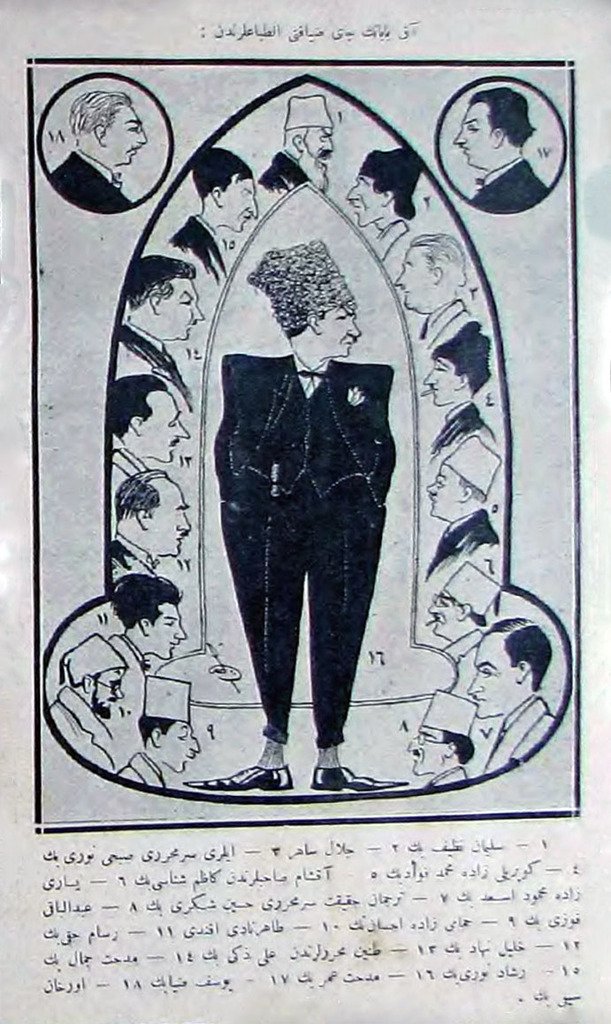
(Cartoon by İsmail Hakkı, Akbaba, 10 December 1923, no. 106
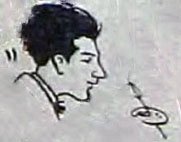
(Detail with İsmail Hakkı and his signature)
It is unlikely that a single issue of Akbaba would include not one, but two caricatures of the same person. Moreover, the two portraits do not look that much alike (even though, this could be an issue of the hand of the caricaturist/s being different for the two portraits, rather than the subject being different). But the plot thickens. The composition of this cartoon resembles that of a calligraphic arrangement. It was not uncommon for Islamic calligraphic panels to take the shape of a dervish’s hat resembling the general outline of what is visible here. (Some examples of the kind of art I am referring to can be found in this article.) Why the sudden reference to traditional arts in this cartoon? Does this suggest that İsmail Hakkı was attempting to combine his interest in calligraphy with cartoons? Does such a visual reference suggest that he was a calligrapher, like his name-twin (or as we say in Turkish, adaş). Or am I just reading what I’d like to see?
The “calligraphy” theme is one that will continue in this analysis, however as I have not yet revealed İsmail Hakkı’s greatest contribution to the Akbaba brand. His work is featured on the cover of every single issue of Akbaba from 4 January 1923 to 1 December 1924 (nos. 9-208) as the masthead used for the magazine at this period bears his signature! Below, for instance, is the masthead from today’s issue of Akbaba from 93 years ago.

(Masthead by İsmail Hakkı, Akbaba, 23 June 1924, no. 162.)
The masthead, which is located at the top of the cover page of journals, usually includes the name of the journal as well as imagery that pertains to the name or content of the publication. In this case, the word “Akbaba” or آق بابا at the center is flanked by two things referred to as “akbaba”, a vulture and a white-bearded old man. İsmail Hakkı’s signature can be found on the arm of the old man who is depicted reading a copy of Akbaba. If all of this feels meta, that’s because it is.
Our mysterious artist’s signature also graces the masthead used by the magazine Zümrüdüanka from 11 January 1923 until 8 January 1925 (nos. 1-209). Below is another example of a masthead from today, coincidentally, 93 years ago.
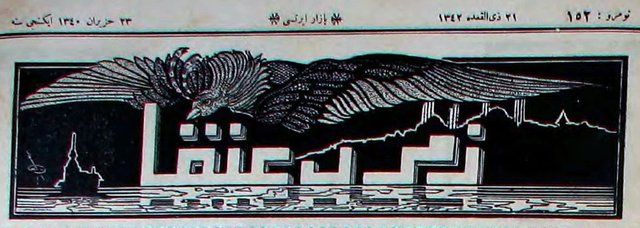
(Masthead by İsmail Hakkı, Zümrüdüanka, 23 June 1924, no. 152.)
The journal’s namesake, a “Phoenix/Zümrüdüanka” can be seen here flying above the Istanbul skyline. The artist’s signature is located on the left, directly above the sparkling waters of the Bosporus. The fact that both mastheads include the names of the journals in eye-catching, calligraphy adds to my suspicion that this İsmail Hakkı may be the same “İsmail Hakkı Baltacıoğlu” who was a calligrapher, university president, and celebrated reformer. Still, however, this is mere speculation based on circumstantial evidence.
While photographs of the lost “İsmail Hakkı the Artist” do not exist there are photos of his name-twin, İsmail Hakkı Baltacıoğlu. I will leave you with some of them, below, and you can decide for yourself whether or not you think he looks like any of the portrait caricatures featured in this post… At the very least, they should bear some resemblance to İsmail Hakkı, the new University's President!
Until the next installment,
Cheers


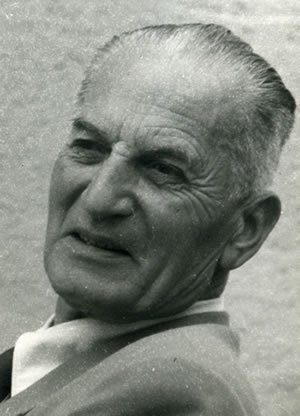
A big warm Steemit Sunday greeting goes out to you YG! :-D
Upvoted and High Pawed!
Plus Bonus. :-)
Flatrider
LOL! Love the paw hi-five:)
Yeah! High Paw! :-D
Oh the glories of the internet! I have an update on this particular "curious case." The puzzle of the artist's identity is not yet solved but since publishing this post my hypothesis about the artist's identity has been disproven! I was recently contacted by a descendant of İsmail Hakkı Baltacıoğlu stating that he was in fact, not a caricaturist, and of course, not the caricaturist associated with this post.
While I regret that my hypothesis was wrong, and that there is still little information about this cartoonist, I am happy that the connective power of a world-wide web has provided answers!